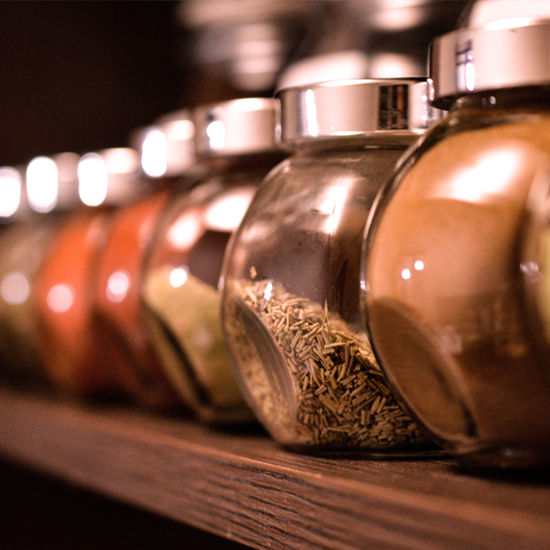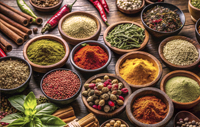
Let’s talk about one of the biggest culprits behind inflated grocery bills: those tiny jars of spices that somehow cost more per ounce than premium steak. If you’ve ever walked down the spice aisle and winced at paying $6 for a small bottle of oregano, you’re not alone. The good news? You can build an impressive spice collection and transform your home cooking without emptying your wallet.
Here’s the reality: name-brand spices at regular grocery stores are marked up nearly 97%. That small bottle of cumin you just bought? You’re paying premium prices for fancy packaging and brand recognition. But once you know where to look and how to shop smart, you can slash your spice spending while actually improving the quality of what’s in your cabinet.
Here are smart shopping strategies that work:
- Explore international markets
This is hands down the best-kept secret for affordable spices. Indian, Mexican, Middle Eastern, and Asian grocery stores sell the same spices you find at regular supermarkets, but in larger quantities and at fraction of the cost. A massive bag of turmeric that would cost $20+ at a chain store might run you $3 at an international market. Plus, these stores have high turnover, which means fresher products.
- Explore international markets
- Embrace bulk buying (strategically)
Health food stores and specialty shops often have bulk bins where you can buy exactly what you need. This works especially well for expensive spices you’ll use sparingly or when you’re trying a new recipe and don’t want to commit to a full container. Look for stores that keep bulk spices in glass containers rather than plastic bins for better quality.
- Embrace bulk buying (strategically)
- Don’t overlook dollar stores
It may be hard to believe but dollar stores can be goldmines for basic spices. A 3-ounce container costs around $1.25 compared to $3-5 at regular grocery stores. Stick to common spices like black pepper, garlic powder, and chili powder. Just check that the spices look vibrant and smell strong — good spices should have rich colors, not faded or dull appearances.
- Don’t overlook dollar stores
- Consider warehouse stores carefully
Places like Costco offer incredible per-ounce value, but only if you’ll actually use those large quantities. Ground spices maintain peak flavor for 6-8 months, while whole spices can last 3-4 years. If you’re feeding a large family or cook frequently, warehouse stores make sense. If not, you might end up wasting money on spices that lose their potency
- Consider warehouse stores carefully
- Make your spice budget work harder
Choose whole over ground. Whole spices cost less per ounce and maintain their potency much longer than pre-ground versions. A coffee grinder dedicated to spices (around $15-25) pays for itself quickly. You’ll get fresher flavor and better value.
Create your own blends. Store-bought spice packets can cost $1-3 each, while homemade versions cost pennies. Taco seasoning, for example, is just chili powder, cumin, paprika, oregano, garlic powder, onion powder, and salt. Italian seasoning combines basil, oregano, parsley, garlic powder, and onion powder. Making these yourself saves money and lets you control salt levels too.
Store properly to protect your investment. Proper storage extends spice life dramatically. Keep spices in airtight containers away from heat, light, and moisture. Glass jars work well and can often be repurposed from other products. Label everything with purchase dates so you know when to replace items.
Grow high-value herbs. Even apartment dwellers can grow herbs in containers on windowsills. A $3-4 starter plant can produce 50 times more than a single grocery store package. Focus on expensive herbs you use frequently: basil, cilantro, parsley, and thyme offer the best return on investment.
- Make your spice budget work harder
Building a well-stocked spice cabinet is an investment that pays dividends in every meal you cook. The money you save by shopping smart can go toward higher-quality main ingredients, making your entire food budget work harder.

Did you know? Consumer Reports quality test
Consumer Reports found that cheaper spices often taste just as good as expensive brands, suggesting that much of the premium pricing reflects marketing and packaging rather than actual quality differences. The key is knowing what to look for: vibrant colors, strong aromas, and proper storage.

I found this article very interesting. We use a lot of spices since my husband is a severe diabetic and spices make the food go down so much easier. Thanks for all the info.
I enjoy using a wide variety of spices when cooking. I know that the prices run high for each of these, so I tend to only buy small sized quantities of spices. I also make sure that they are the kinds that can be used for more than just a couple of recipes. I try to make good use of them before expiration dates. I have also found a couple of stores where I can purchase spices much cheaper than in regular grocery stores. I have found that they taste just as good and they work just as well in my recipes. I can save money, not waste expensive spices and still cook recipes using some of the special blends of spices.
I like the cheaper ones
It’s a great idea
Interesting information! Thank you for sharing!